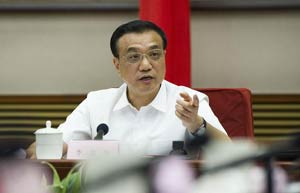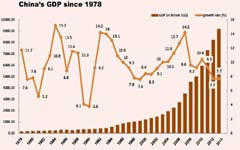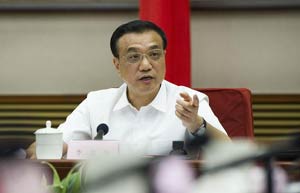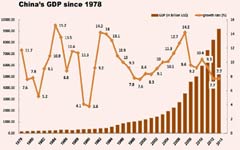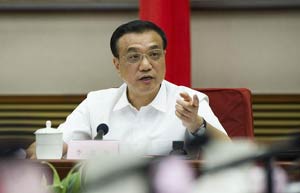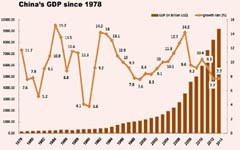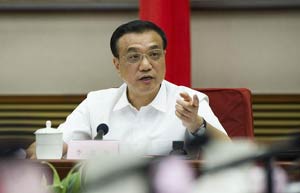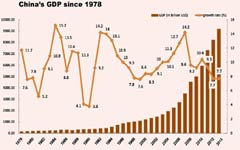China's economy heading in the right direction
CMS (2014-07-29 15:50) [Full Text]
 |
|
LI MIN/CHINA DAILY |
Healthy growth in services brings new momentum to economic restructuring
Is the economy at last turning? The Chinese government's policies to rebalance the economy seem to be bearing some fruit at last.
The latest economic data published by the National Bureau of Statistics on July 16 suggest China is moving to a more service-based economy that is less reliant on exporting cheap manufactured goods.
On the expenditure side of national income, consumption also continued to play a stronger role, contributing the largest share of GDP growth.
Achieving such shifts was the central aim of both the current 12th Five-Year Plan (2011-15) and last year's Third Plenum meeting-setting the economic course for the next 10 years.
In the second quarter of this year, services accounted for 48.9 percent of GDP growth, compared with 47.1 percent for the secondary sector, mainly comprised of manufacturing.
This represented a complete turnaround from the second quarter of 2012, when services accounted for just 42.7 percent of growth with the lion's share (53 percent) fueled by the secondary sector.
Consumption also accounted for more than half of GDP growth for the second quarter in a row. It made up 54.4 percent, compared with 48.5 percent for investment, while net exports made a negative 2.9 percent contribution. Although the figure for consumption was down from the 64.9 percent in the first quarter, it could still provide evidence of a continued rebalancing.
The picture certainly appears better than last year when investment actually increased as a share of GDP from 45.7 percent in 2012 to 45.9 percent, mainly as a result of the mid-year mini stimulus for targeted infrastructure projects. Consumption also increased only marginally last year from 49.5 to 49.8 percent.
Central to the government's rebalancing strategy are initiatives such as the Shanghai Free Trade Zone, launched last year and at the vanguard of China's financial reforms.
Other moves involve setting up a better social security and health-care system so people become less reliant on having to save and can therefore consume more.
A major reform also involves the hukou, or household registration system, giving greater rights to migrant workers and their families to settle in cities and become consuming citizens.
Underpinning the reforms also is a change in mindset, with the government already demonstrating that it is less inclined to embark on major infrastructure projects just to maintain GDP growth at artificially high levels.
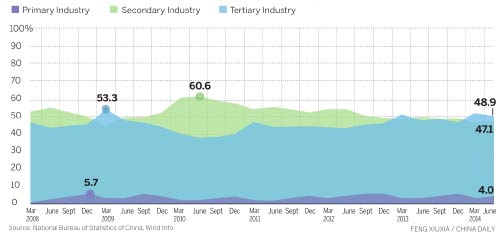 |
|
FENG XIUXIA/CHINA DAILY |
It did, however, announce in April a minor stimulus aimed at more social housing construction and accelerating railway development.
George Magnus, senior independent economic adviser for UBS in London, says the recent data clearly shows a trend.
"I think there is little question that rebalancing is happening. It was always going to happen in my view. The only questions were how and how quickly," he says.
The economist, who was author of Uprising: Will Emerging Markets Shape or Shake the World Economy, which warned of the risks of an investment bust in China if rebalancing did not take place, points out that one of the indicators of rebalancing is a decline in property investment.
Real estate investment was 4.2 trillion yuan ($677 billion) in the first six months, a 14.1 percent increase over the same period last year but down from increases of more than 19 percent that predominated throughout 2013.
"We can see the start of a protracted downswing in property and construction investment. This is of huge consequence as this sector has been the leading edge of China's expansion for over 10 years," he says.
Duncan Innes-Ker, regional editor for Asia at the Economist Intelligence Unit in London, says one explanation for the strong first half data suggesting rebalancing is the increased role consumption tends to play in the early part of the year.
"The first thing to remember is that consumption tends to be much stronger in the first quarter of the year in China, owing to the timing of the Chinese New Year, which means that you quite often see its contribution to GDP growth starting off strong and then easing through the rest of the year."
Innes-Ker, who was previously a senior China economist of the EIU in Beijing, senses, however, that this time there may be a more fundamental change taking place.
"There are good reasons to expect that consumption will play a more important role this year. The weakening of property investment is unlikely to be reversed anytime soon, and will play a big role in dampening investment's contribution to growth.
"The underlying outlook for consumer demand also remains very positive, with incomes rising at double-digit rates and fields such as e-commerce expanding at a phenomenal pace."
Mark Williams, chief Asia economist at Capital Economics, also in London, says interpreting the China rebalancing story often depends on whether you are an optimist or pessimist.
"The glass-half-full view is that the imbalance has stopped getting worse. The half-empty view is that the difficult transition of weaning the economy off investment has not yet begun."
He does, however, believe there are some positive trends that suggest rebalancing is actually taking place.
"There has been a big slowdown in real estate construction. It might be giving people the jitters now but it is needed for the overheated construction sector to return to a sustainable path. Meanwhile, other parts of the service sector have continued to do well."
He, too, believes it is difficult to make firm judgments based on the last two quarters' data.
"If we look over the past four quarters, consumption and investment have contributed roughly the same to growth and this suggests both have now stabilized relative to GDP."
Jonathan Garner, chief Asia strategist of Morgan Stanley, based in Hong Kong, is confident China is achieving rebalancing and is now at the point Japan reached in the 1970s and South Korea in the 1980s.
"If you look at the economic history of both South Korea and Japan, China is about to reach the GDP per capita that they both reached when a consumer society took hold.
"At that point, most of the physical infrastructure has been done and the savings ratio begins to fall."
Garner, who presented his own research on China's rebalancing and reform agenda in Beijing last month, says much of the evidence of rebalancing is seen in consumption data. The number of passenger cars registered in the first five months of 2014, according to Morgan Stanley research, increased 15.5 percent over the same period last year, faster than items associated with investment spending, like cement consumption increasing 5 percent and that of steel just 3 percent.
"These are drawn from the official China statistics and it is a trend that has been running for three to four years and still has further to run," he says.
Louis Kuijs, chief China economist at the Royal Bank of Scotland, also says it is difficult to make solid assessments on the 2014 data to date.
"I think data relating to consumption, investment and exports can be pretty decent at an annual level but more problematic in making firm conclusions about it at a quarterly level," he says.
He is prepared to give the government some credit with its policy responses and actions.
"I think government policies like exchange rate appreciation have shifted the terms of trade in favor of the nontradable sector, which tends to favor the domestically oriented services sector," he says.
This was one of the factors that led services to increase as a proportion of GDP from 44.6 percent in 2012 to 46.1 percent last year, while the secondary sector declined over the same period from 45.3 to 43.9 percent.
"Some of the change can simply be explained by relative price changes, however. There has been downward pressure on factory gate prices over this period, which affects manufacturing but not services. So what you might be seeing also in the statistics is the price impact on the data and not volume effects."
Yifan Hu, managing director, chief economist and head of research at Haitong International, the Shanghai-based securities firm, says rebalancing the economy is a long haul.
At the start of the decade, the government set itself the goal of doubling China's per capita income by 2020.
【Disclaimer】
The recommended or reviewed securities in this comment doesn’t have any stake in the interest of the company and authors. Analysis of the company and individuals in this website cannot be used as any decision support but consultant for investment.
